Family : Malvaceae

Text © Prof. Pietro Pavone

English translation by Mario Beltramini
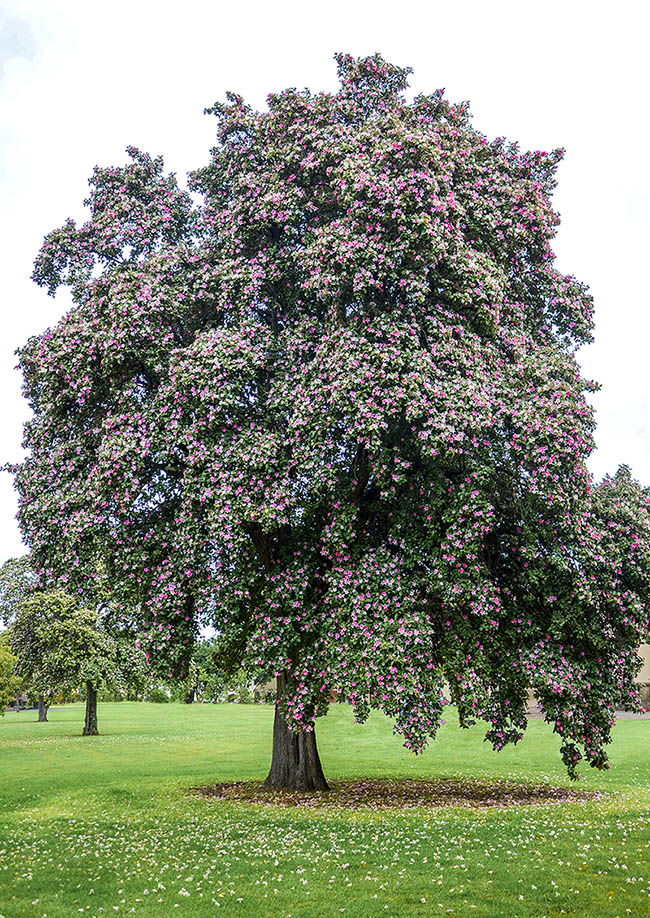
Lagunaria patersonia is an Australian evergreen that may be 15 m tall © John T. Jennings
Lagunaria patersonia (Andrews) G.Don is a species of the family Malvaceae, subfamily Malvoideae, native to the coastal areas of Australia (Queensland and New South Wales), of Lord Howe Island and of Norfolk Island, typical of the humid tropical biome.
The name Lagunaria has been attributed, for the first time, by Colonel William Paterson (1755-1810), acting governor in New South Wales (Australia) who sent in England the seeds he had collected in Norfolk Island in 1792.
This name was not taken into consideration by Augustin Pyrame de Candolle (1806-1893) who instead believed that the plant he had received had to be included in the genus Hibiscus.
But in 1828, Heinrich Gottlieb Ludwig Reinchenbach (1793-1879), professor of natural history in Dresden University and author of botanical systematic works of fundamental importance, believed that the plant should not belong to the genus Hibiscus but to a different genus and for such reason reassigned the name Lagunaria (DC.) Rchb. in his work Conspect. Reg. Veg. 202 (1828).
The species was described by George Don (1798-1856) in Gen. Hist. 1:485 (1831) with the name of Lagunaria patersonii that kept its synonyms Hibiscus patersonius Andrews and Lagunaea patersonia Sims.
However, based on the International Code of Nomenclature for algae, fungi, and Plants (ICN), entered into force in 2012, the correct name is Lagunaria patersonia (Andrews) G.Don.
The name of the genus Lagunaria is to honour Andrés de Laguna (1499-1559), naturalist, botanist, physician and humanist. His translation of the original text “De materia medica” by Pedanius Dioscorides (c. 40 – c. 90 AD) into Castilian with commentaries and additions.
In fact, he personally verified all Dioscorides’ prescriptions collecting the same plants in many parts of Europe and so as to add to the translation his own experience of botanist and of pharmacologist.
The specific epithet is honoured to William Paterson who, being a passionate botanist, collected the seeds and reported the plant as shown in his manuscript during his stay in Norfolk Island between November 4th, 1791 and March 9th, 1793.
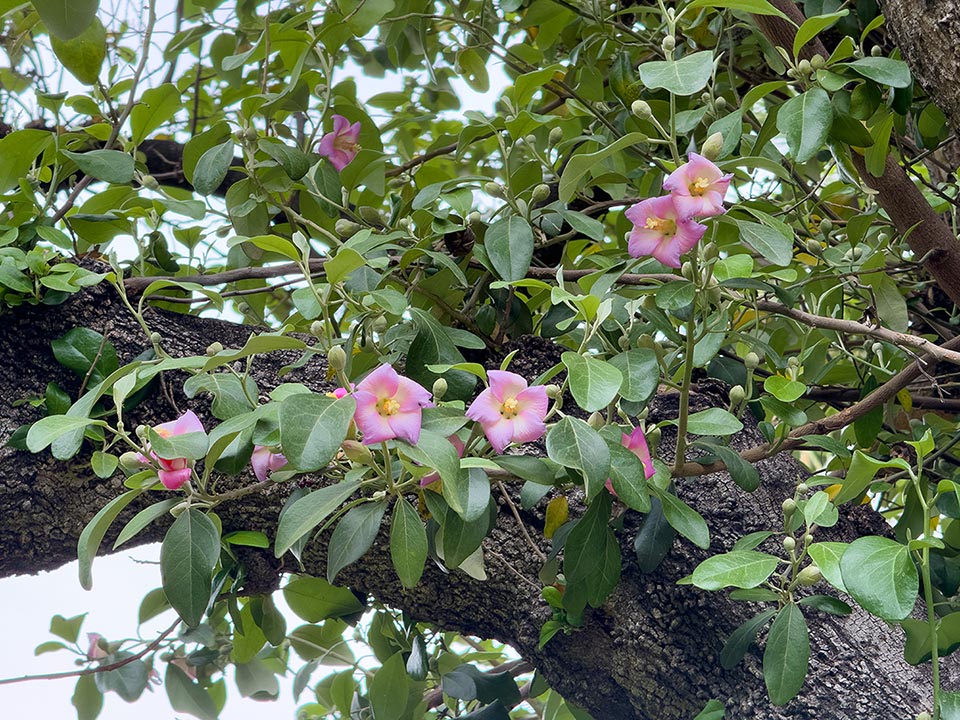
Native to Queensland, New South Wales, Lord Howe and Norfolk islands coasts it grows well also in the Mediterranean climates © Giuseppe Mazza
Commonly, this species is called Pica-pica tree, Norfolk Island hibiscus, Queensland white oak, Pyramid tree, Confetti tree, Witches’ tree, Primrose tree and, due to its itchy hairs, in English, “Itchy bomb tree”, “Cow itch tree”.
Lagunaria patersonia is an evergreen tree, fast growing, up to 15 m tall, with pyramidal crown and young tomentose branches.
The leaves, alternatively arranged, are petiolate, oblong to widely lanceolate, 5-10 x 2-5 cm, with obtuse to arcuate base and with entire margin and normally obtuse or rounded apex. They are coarse, of dark green colour on the upper pagina, hairy-tomentose, silvery white to greyish on the lower one initially, then later on getting glabrous and pale green on both sides.
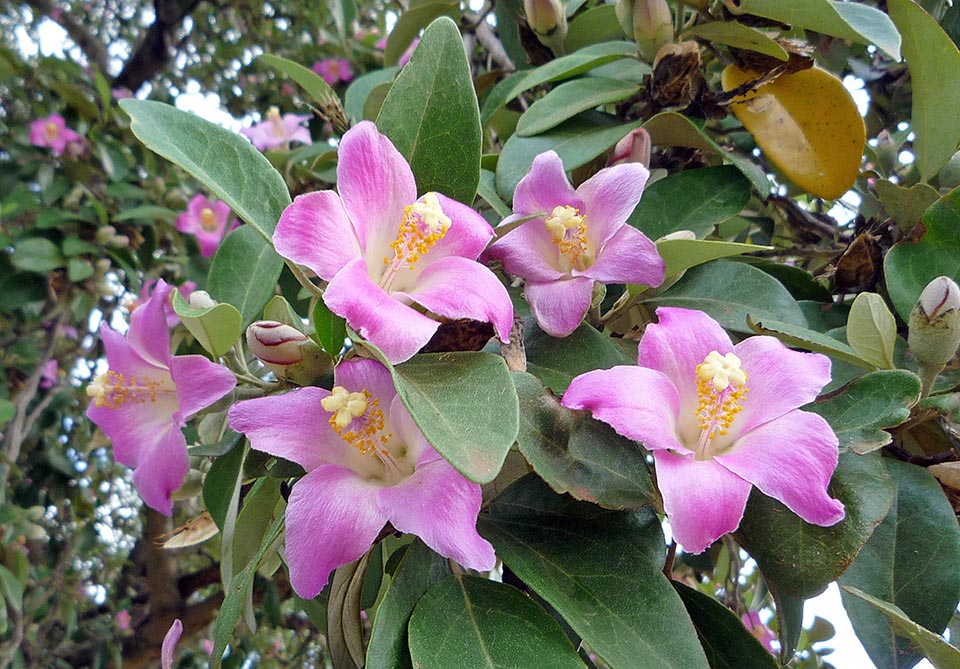
The hermaphrodite flowers, mauve pink but at times even yellowish or white, are of 3-5 cm of diameter and appear in summer on the upper leaves axil © Alison Klein
The flowers appear on the axil of the upper leaves and are hermaphrodite, solitary, campanulate, of 3-5 cm of diametre, similar to those of the hibiscus on short and thick pedicels, with epicalyx, formed by precociously deciduous bracts, having protective function on the flower when this is still closed.
The calyx has a bell-cupuliform shape and is 1,2-1,5 cm long, tomentose, with five 2-3mm lobes broadly triangular. The corolla is formed by 5 elliptic-lanceolate petals, curved, of pink or mauve colour, at times yellowish or white when mature, 4-4,5 cm long, pubescent outside and glabrous inside. The androecium is formed by numerous stamens merged on the filaments tubular shaped, with yellow or orange anthers. The gynoecium is done by 5 carpels that form a white or cream superior ovary, divided in 5 stigmatic lobes at the extremity of the staminal column.
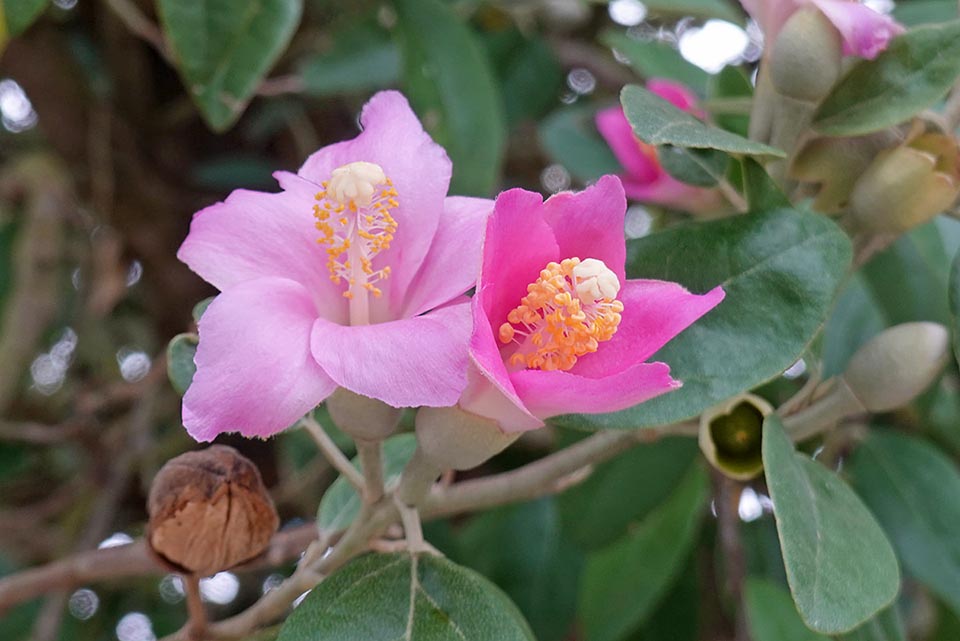
In small they recall the hibiscus ones that in fact belong to the same family of the Malvaceae © Boeckli
Blooming occurs in summer. In the origin sites between the months of October and February.
The fruit is a globular capsule of 2-3 cm of diametre, lignified, externally tomentose, tha remains on the plant for several months. When ripe, it opens in 5 valves, with inside rigid, white and itchy hairs. The 5-6 mm seeds are reniform, red and smooth.
Natives utilize this plant as a source of fibres for making fishing lines and nets, bags, baskets, twines and ropes.
It multiplies by seed in spring or by cutting of semi-mature wood in summer.
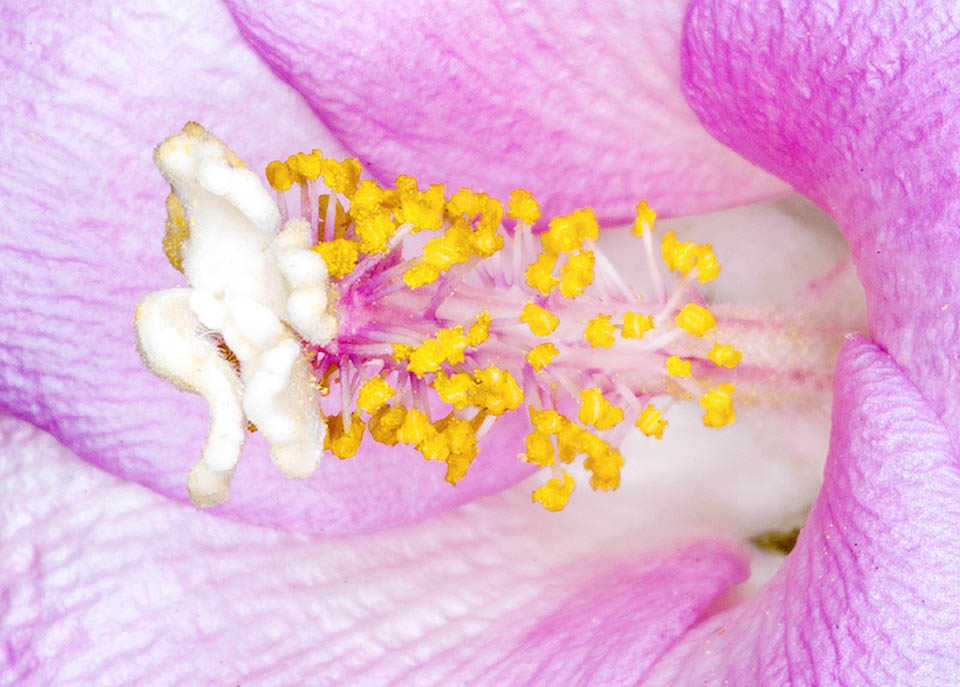
In both the stamens filaments form, merged, a column rich in golden anthers ending in a white or cream style divided in 5 lobes.
In the past they thought that the genus Lagunaria was monospecific with two subspecies, one coming from Norfolk Island (Lagunaria patersonia (Andrews) G.Don subsp. patersonia) and the other (Lagunaria patersonia subsp. bracteata (Benth.) P.S.Green) of Queensland.
In 2006 the botanist Lyndley Alan Craven (1945-2014), researcher of the Australian National Herbarium, recognized the two subspecies as distinct, elevating them to the specific rank, respectively with the names of Lagunaria patersonia and Lagunaria queenslandica Craven (Blumea 51: 352, 2006). The two species differ for the leaves that in Lagunaria patersonia are fleshier and with the lower pagina whitish tomentose, and also for the length of the style that is bigger in Lagunaria queenslandica because the petals are shorter.
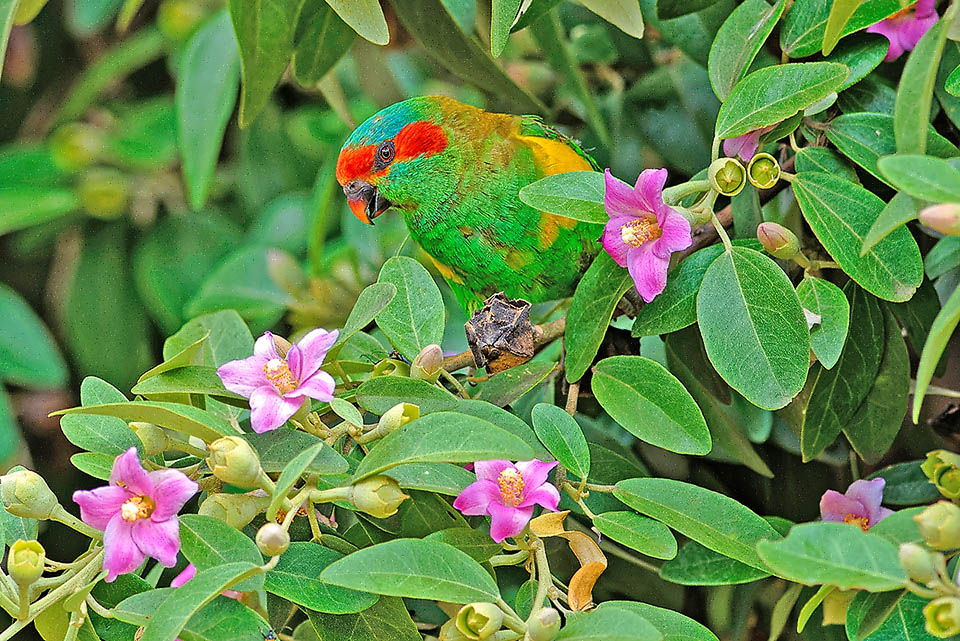
Here a New South Wales lorikeet (Glossopsitta concinna) attracted by the nectar, present also on the lower glandular part of petioles in the young leaves © Adam S. Kraska
Furthermore, this last species is found only in Queensland in the rainforest, along the coasts and the rivers, with a dry season during the winter months. The swampy forest with Lagunaria of Lord Howe Island has been considered an ecological community in grave danger (Critically endangered) by the New South Wales government that also administers the island, according to the Threatened Species Conservation Act (1995).
Due to the beauty of its blooming, the elegant posture and its capacities to resist salinity, Lagunaria patersonia is an ornamental plant diffused in the public gardens and in the road rows, in several coastal areas of the world, mostly characterized by temperate-warm and humid subtropical climates.
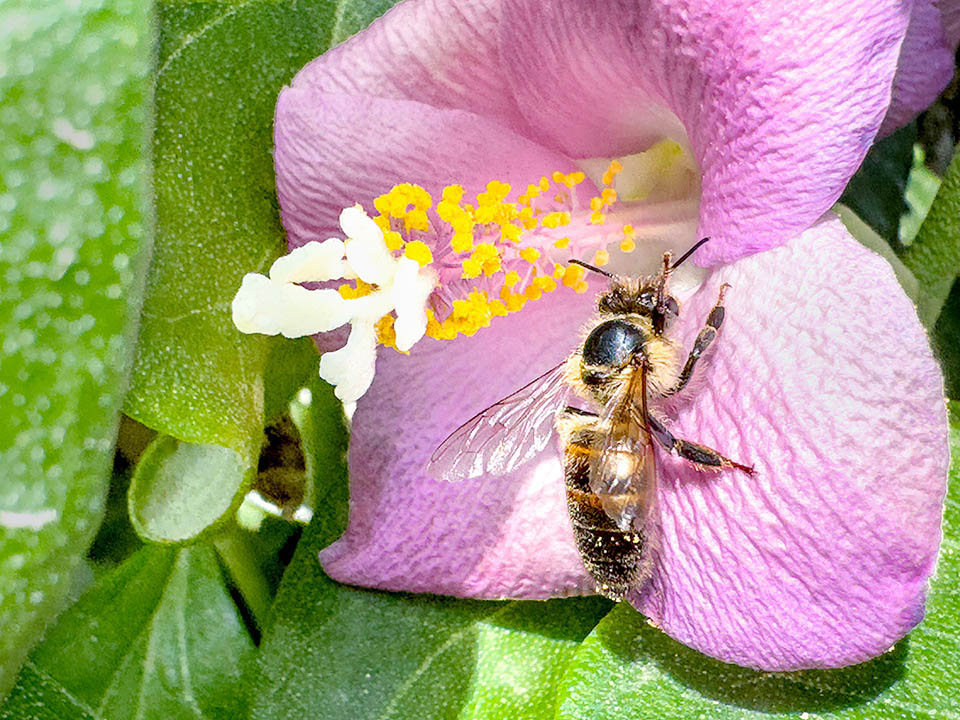
Also the insects care the pollination naturally, and in the Mediterranean gardens the bees do enter and exit the corollas © Giuseppe Mazza
It is present in western Australia, in southern Africa, in central America, in the Hawaii islands and in some coastal areas of the Mediterranean. The plant prefers fertile, well drained soil, and sunny expositions, preferably, where the minimum temperatures do not fall below 7-10 °C. However, It may stand poor soils, saline fog and for short times, temperatures slightly below zero (up to -4 °C).
The presence in the fruits of the very fine stinging hairs that may cause allergies, slows down its use in the areas reserved for the children.
It is fairly resistant to pests and to diseases, but may be attacked by the insect Tectocoris diophthalmus, diffused in eastern Australia, in New Guinea and in various Pacific islands. This insect feeds on the leaves, the fruits and the seeds and sucks the sap from the stems.
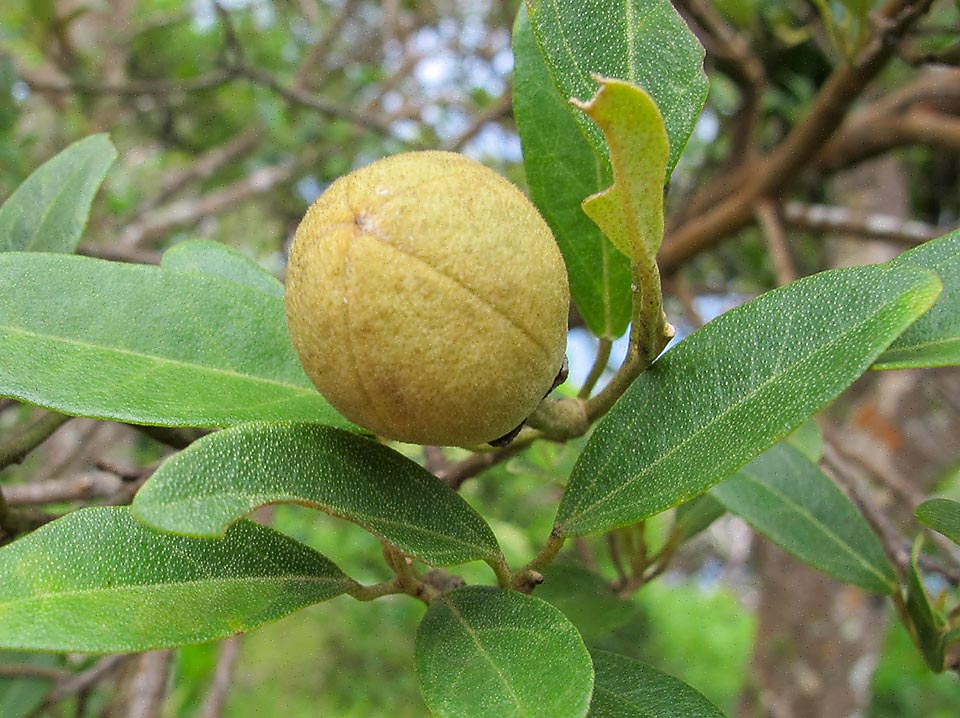
The fruit is a globular lignified capsula of 2-3 cm of diameter. It opens when ripe in 5 valves, freeing smooth red reniform 5-6 mm seeds and rigid hairs, white and itchy © Spelio Flickr
The females lay their eggs around the base of the stems, but rarely they cause serious damage to the survival of the plant.
In New Zealand, Lagunaria patersonia is attacked by the basidiomycetic fungus Puccinia plagianthi and also by the olive tree scale insect Saissetia oleae. In southern Italy, on some plants, has been observed the disease of wilting caused by the ascomycetic fungusVerticillium dahliae.
The species appears nowadays as “NT, Near Threatened“, in the IUCN Red List of the endangered species.
Synonyms: Hibiscus patersonius Andrews; Hibiscus patersonii R.Br.; Laguna patersonia (Andrews) Sims; Laguna squamea Vent.; Lagunaria patersonia var. typica Domin; Solandra squamea Poir.
→ To appreciate the biodiversity within the MALVACEAE family please click here.
